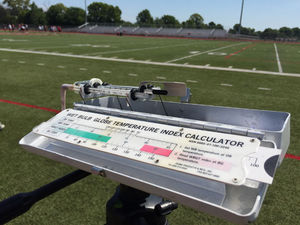
It’s been more than 60 years since Paul “Bear” Bryant held Texas A&M’s preseason football practices in Junction, Texas. After a breakfast of vitamins, orange juice and salt pills, the players hit the field for practice sessions conducted without water breaks. The 10-day camp saw several triple-digit temperatures and many heat-related illnesses.
It’s safe to say no one in Christian County will see that kind of preseason camp.
With time has come better information about the effects of heat and dehydration on athletes, and administrators, coaches and certified athletic trainers are doing a better job of minimizing exertional heat illness and exertional heat stroke.
“This kind of heat and these kinds of conditions have been around since we were all kids and everybody survived,” Ozark High School Activities Director Terry Jamieson said. “We all got through it, we all kept ourselves hydrated. Dealing with the heat requires thoughtful coaches and thoughtful administration. The kids can make it through it and you can work out in it as long as you’re intelligent and plan ahead.”
The National Athletic Trainers’ Association says that from 2010-15 there were 20 athletic heat stroke fatalities reported. None were in Christian County, however, and several coaches can’t recall any problems with heat-related illnesses.
“We’ve got our (certified athletic) trainer and he lets us know what the heat index is going to be and we have to make changes accordingly,” Nixa soccer coach Evan Palmer said. “If it’s between 95 and 105, we have to take more breaks. I usually make sure they get water every 10-15 minutes when the heat index is that high. If it’s over 105 we have to push back practice times until it goes back down.”
That guideline has been passed down from MSHSAA, which published a “Position Statement and Recommendations for Maintaining Hydration to Optimize Performance and Minimize the Risk for Exertional Heat Illness” on its website. The organization has also implemented a 16-day acclimatization period, with a schedule of practices to make sure that athletes aren’t forced into doing too much too soon.
“MSHSAA does a good job,” Jamieson said. “They’re very thoughtful about all the information they put out to us. I think since MSHSAA’s got involved it’s drawn some awareness to it.”
On-site certified athletic trainers also play a vital role in keeping players healthy. Neil Moore, of CoxHealth, is the certified athletic trainer for Nixa. He not only provides education on EHI and EHS to the athletes, but he is also there to monitor things first-hand.
“While I am at practice, I am always monitoring the condition of my players, being on the lookout for those who are particularly heavy sweaters, or ‘salty’ sweaters as indicated sometimes by the white rings of sweat that form on the T-shirts around the arm pits,” Moore said. “But I am also looking for individuals who have stopped sweating, or who are starting to show signs of distress. Coaches and other players also sometimes can spot when someone is struggling and will often bring it to my attention. In those cases, it is wise to not take chances.”
Not taking chances has included adjusting practice times. Nixa softball, for instance, starts its tryouts at 6:30 p.m. Nixa football didn’t start its first day of fall practice until 5 p.m.
“I know for me personally, all the years I coached, I enjoyed practices later in the evening when the sun wasn’t straight overhead,” Jamieson said. “But occasionally we would do the 3 or 4 o’clock in the afternoon practices just to make sure, because sometimes in the fall you may have to play a game on a 90-degree day.”
That’s especially true for sports like football and soccer, which are typically played on artificial turf in Nixa and Ozark. The turf, with its black rubber pellet fill, radiates and intensifies the heat.
“It gets pretty hot out there at times,” Palmer said. “But we have to get used to it in case there are games that are at that time and in that heat.”
Jamieson said a healthy balance of workouts and breaks is key, as is common sense. Communication, Moore said, is also important.
“Constant communication is really key to avoiding an emergency situation, and everyone involved has a duty to speak up if something doesn’t seem right — whether it is a symptom one is experiencing himself, or a sign one is seeing in someone else,” Moore said. “The bottom line is that EHI can kill, and therefore, it must be taken seriously, which means cautious preparation and diligent monitoring are two of the best defenses in fighting its effects. When those efforts fail, immediate, rapid and thorough emergency measures being employed could very well be the only difference between life and death. So, ‘be prepared, be alert, and be swift to intervene’ is my motto.”
ORIGINAL ARTICLE:
http://ccheadliner.com/be-prepared-alert-swift-administrators-coaches-trainers-work-to-keep/article_0991113a-70c5-5d50-9f22-8697c4283d89.html